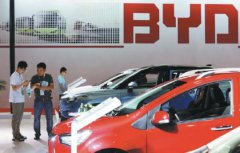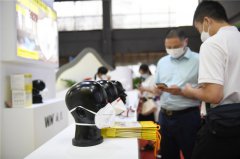Ford CEO: Electric vehicle demand will transform industry
A new electric version of Ford’s immensely popular F-150 pickup truck might just be the catalyst that hastens America’s transition from gasoline to battery powered vehicles
May 21, 2021, 7:00 PM
6 min read
Share to FacebookShare to TwitterEmail this article5:44
President Joe Biden says his infrastructure plan would create more jobs in green energy.
The Associated PressDEARBORN, Mich. -- A new electric version of Ford's immensely popular F-150 pickup truck might just be the catalyst that hastens America's transition from gasoline to battery-powered vehicles.
Jim Farley, the company's new CEO, calls the introduction of an electric version of the nation's top-selling vehicle a watershed moment for Ford as well as for the auto industry. The new truck, called the F-150 Lightning and due in showrooms by next spring, will be able to travel up to 300 miles (480 kilometers) per battery charge and tow up to 10,000 pounds (4,500 kilograms) .
Yet Ford's commitment to the EV F-150 is hardly without risk. The company spent millions to develop the truck at a time when sales of electric vehicles remain minuscule — just 2% of the U.S. auto market. Many truck owners will be reluctant to switch from gasoline engines. And there's the distinct possibility that at least in the early months and perhaps years of production, automakers could run short of EV batteries and the scarce precious metals needed to make them.
The Associated Press spoke recently with Farley about electric vehicle sales and a global chip shortage that has hindered auto production. The interview was edited for clarity and length.
———
Q: Why is the Lightning so important to Ford, and why are you offering an electric version before other models?
A: We’re starting with our icons because we know the customers the best and we can surprise them with the best execution. But the real key is the scale. We sell 1.1 million (F-Series) units a year. So these customers really trust us. If there’s a company who’s going to take them into an electric future, it’s Ford.
———
Q: You’re at a base price of roughly $40,000. With a $7,500 federal tax credit, will you be even cheaper than a gas-powered F-150?
A: It’s going to be pretty close. It depends on the specifications. The vehicle is faster than a Raptor (F-150 high performance gas version.) It'll power your house for three days or a heck of tailgate. We have the latest interior technology, over-the-air updates. You could argue it’s going to give the internal combustion product a heck of a run.
———
Q: How long do you think it will be until the majority of vehicles you sell are battery electric?
A: A lot of it will depend on government support, the infrastructure (charging stations) build-out, as well as a support for the purchase. We have a $7,500 benefit still at Ford. So it depends on what happens with government policy, and whether that tips the scale for a lot of customers. It has in Europe. China is moving fast. We're totally sold out with the Mach E (Electric SUV). On the West Coast, it's already changed quickly. It’ll be a matter of time before that sweeps across the country.
———
Q: You have said the global semiconductor shortage will halve your normal production in the second quarter. Do you see that shortage ending this year?
A: These components are a high percentage of our build-of-material these days, and we can’t really continue to run just-in-time inventory on components like this. It’s a real game changer in how we look at our supply chain. We are seeing some positive indications from chip producers. The big change is the Renesas facility (a chip factory in Japan that was damaged by fire) coming back online. As that facility ramps up to 100%, we'll feel a lot more confident. So we’re not through this. I’m not going to give any predictions about what the second half looks like.
———
Q: Does that 50% production loss figure for the second quarter change?
A: Certainly in the second half we see much less impact. We had about 200,000 units of lost production in the first quarter. The second quarter is going to be the most difficult. We see, conservatively, a couple of hundred thousand units of risk in the second half.
———
Q: You've mentioned that you may buy chips directly from the factories and stockpile them. Is this going to change the way Ford buys critical parts?








